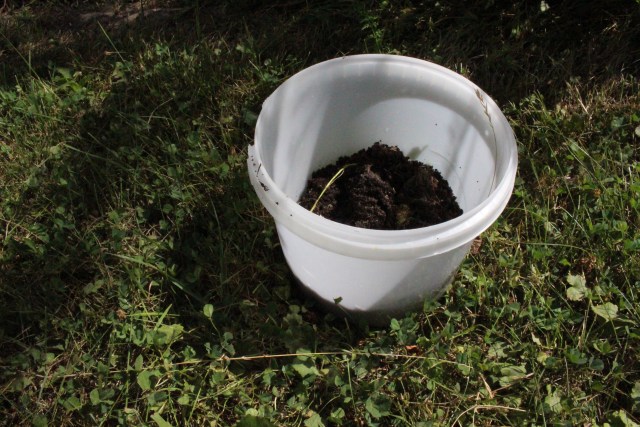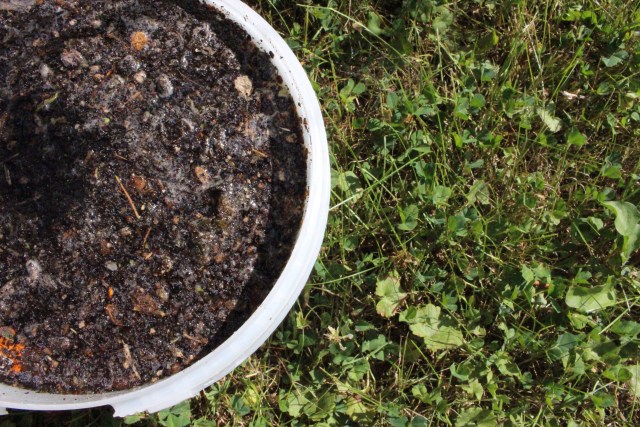Welcome to This Is How We Do It, a new series wherein we’ll be discussing projects both inside the home and out and explaining, you know, how we do it.
I planted my garden at the beginning of summer, when it was just starting to get hot more than occasionally. Were we ever so young! The yard of my apartment was blessed with a compost container, so I was able to plant my baby vegetables with lots of compost to help them grow strong and healthy. Now that my plants are grown, they need more plant food, and I want to feed it to them without disturbing their root systems by shoveling around in there. The solution: liquid fertilizer! I could buy Miracle-Gro, or I could make some easily (and organically) at home. There’s more than one way to do this, but I made what’s called “compost tea,” or liquid fertilizer derived from compost. It’s just stupid easy, I promise.
1. Find a bucket or other large container, and fill it halfway or so with compost.
It’s okay if it’s not all totally decomposed/composted or if there are still chunks of vegetable matter, just shovel it all in there.

2. Fill the rest of the container with clean water.
You can cover the bucket with a lid at this point if you wish; it’s not a big deal whether you cover it or not, it will just smell a little less like compost if you do.

3. Let the “tea” sit for a few weeks, stirring frequently.
Most instructions call for about three weeks, although if your compost is really A+ material and is already very nutritionally rich, you could do less time. It should be stirred frequently, once a day if you can, to introduce oxygen into the mixture, which will help the microbes you need.
4. Dilute and feed to your plants!
The liquid in your container should now be fully functional liquid fertilizer! You can strain the liquid through a mesh or an old t-shirt to separate out the plant matter. Dilute the liquid with water at a ratio of about 1 part fertilizer to 9 parts clean water, and use to water your plants. It should be a light translucent brown, not unlike a glass of iced tea. You can re-use the plant matter with more liquid to create more fertilizer. Your plants will thank you.

If you don’t have any compost to work with (here’s an easy way to get started!) you can use grass clippings or leftover vegetable and plant matter instead. While not technically a fertilizer, you can also use Epsom salt as an additive either to the soil or in the form of a spray for tomato and pepper plants; you can dissolve two tablespoons of Epsom salts in one gallon of water and use the resulting liquid as often as once a month.








Comments
Yes to plants but I probably will forget to do this until I literally run into the compost bucket.
This is so simple and easy, maybe this will finally help me not kill every plant I come into contact with.
Thanks for this!
I’ll be honest, I saw fertiliser and clicked to see if you were telling me to poo in a bucket… I’ll see myself out.
Omg, me too.
Sooooooo glad it wasn’t just me.
probably don’t poo in a bucket but you can pee on plants sometimes; it’s especially good for roses!
Are you as much of a composting toilet geek as me? Composting toilets are so awesome. PEE IS SO GOOD FOR PLANTS YOU GUYS, WE LITERALLY FLUSH VITAL NUTRIENTS AWAY
maybe i’m over simplifying but what if you just got some kale or seaweed or other green stuff and then blendered it? would this work?
good question! this would probably have some positive effects for your plants, but my understanding is that by letting the fertilizer sit and stirring frequently you’re actually creating a microbial reaction that breaks down the plant matter on a chemical level and thereby makes the mixture very nutrient-rich for your garden. unfortunately i’m not sure there are any shortcuts if that’s what we’re looking for, it just takes a bit of time!
That makes total sense and now I feel a bit silly. Thanks for sharing!
That would certainly fertilize your garden, but one bunch of blended up kale contains about enough fertility to grow one bunch of kale. (A little less, because you lose some nitrogen to the atmosphere during decomposition. Science!) So you’d come out ahead just eating the kale.
The beauty of compost tea (aside from the microbes, as mentioned) is that compost comes from all the stuff that would have gone to the landfill. You’re cycling the waste back in.
If you just want the plant nutrients and don’t want to go to the effort of making tea, you can also put regular compost right around your plants. The nutrients will slowly filter in as you water.
Or . . . you can pee around your plants! Pee is an extraordinarily concentrated fertilizer (concentrated enough to be too much for some plants–you might want to dilute it with water).
Well this was an extraordinarily helpful comment!!
Thanks. This response is great and super helpful!
Rachel covers all the bases. Rachel is a magical human. I am a fan of Rachel.
I’m always here for you and your bases!
I love plants and aspire to have a garden someday… The lil dudes make me happy, y’know? Thank you for the awesome tutorial!
Was anyone else expecting this to include period blood? I just can’t get my mind off that period panel at ACamp.
If only this had come two months ago when I broke down in tears at how much we’d just spent on fertilizer for the garden I started to try to keep our grocery budget down. Anyway, the vegetables are growing and I am no longer quite as broke.
The recipe for compost tea sounds good and it is simple, but you do run the risk of the mixture becoming hypoxic unless you put a constant source of air into the liquid, such as an air pump with an air stone. You do NOT want to put anything on your plants that has become septic, since the bacteria that grows in an anaerobic environment is NOT good for your soil.
I prefer to make manure tea using a processed organic fertilizer, such as MightyGrow Organic 4-3-4. I simply take a 5 gallon bucket, place a cheap aquarium pump in the bottom of the bucket and add 4 gallons of water. I then take a $0.75 paint strainer bag for a 5 gallon bucket (available in Lowes or Home Depot) to hold the pelletized fertilizer. The idea is to simply cycle the water from in the bucket and through the fertilizer for about 24 hours. You will end up with a VERY dark, rich liquid fertilizer that you can dilute 10:1 to water your plants with. You can cycle the nutrient solution a couple of times to get all the water soluble fertilizer out of the mixture.
Once you are done making liquid fertilizer simply spread the damp solids on top of the ground under one of your shrubs and water in. Simple and cheap, you can make liquid fertilizer for less than 5 cents per gallon.
Thank you for sharing these blog post! I learned a lot of ideas while reading it.